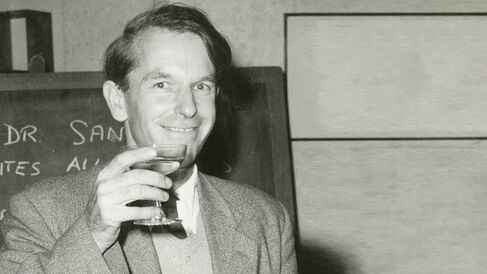Frederick Sanger

Nobel Prize in Chemistry 1958 for his work on the structure of proteins, especially that of insulin.
Nobel Prize in Chemistry 1980 for contributions concerning the determination of base sequences in nucleic acids, shared with Walter Gilbert and Paul Berg.
Department of Biochemistry Part I student (1936-1939), Part II student (1939-1940), PhD student (1940-1943, PhD awarded 1943), Postdoctoral Researcher (1943-1951) and Medical Research Council External Scientific Staff (1951-1962).
Frederick Sanger took Part II Biochemistry at Cambridge, before starting a PhD in 1940 under the supervision of Norman "Bill" Pirie. Pirie, however, shortly moved to the Rothamsted Experimental Station in Harpenden to pursue his interest in viruses, and so Albert Neuberger became Sanger's supervisor for a project on the metabolism of the amino acid lysine. After obtaining his PhD in 1943 Sanger worked with the newly appointed Head of Department, Charles Chibnall, whose previous work on bovine insulin lead to Sanger determining the complete amino acid sequence of its two polypeptide chains. To this end he used fluorodinitrobenzene (now known as the 'Sanger Reagent') to label N-terminal amino group acids and refined the methods of Richard Synge and Archer Martin to fractionate mixtures of peptides in two dimensions (first by electrophoresis and then by chromatography) to generate what Sanger called 'fingerprints'. The finding that the two polypeptides of insulin had distinct amino acid sequences carried the implication that every protein had a unique sequence. For this work Sanger received his first Nobel prize in Chemistry in 1958.
When the Medical Research Council opened the Laboratory of Molecular Biology in 1962 Sanger moved from the Biochemistry Department to the new building opposite Addenbrooke's Hospital. He developed methods for the sequencing of RNA before turning to DNA and by 1975 he and Alan Coulson had come up with a way of generating short oligonucleotides with defined 3' termini that could be fractionated on a polyacrylamide gel. This lead to the first complete sequence of a DNA genome, that of the bacteriophage φX174.
By 1977 Sanger and colleagues had developed the 'dideoxy' chain-termination method for sequencing that permitted rapid and accurate sequencing of long stretches of DNA. For this Sanger shared the 1980 Nobel Prize in Chemistry with Walter Gilbert and Paul Berg. This 'Sanger Method' was used to sequence human mitochondrial DNA (16,569 base pairs), bacteriophage λ (48,502 bp) and the worm genome (~100 million bp) before it was eventually used to sequence the entire human genome, a project that was completed in 2003.
Sanger is one of only two people to have won two Nobel Prizes in the same category.
